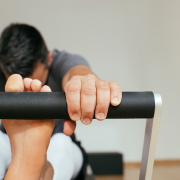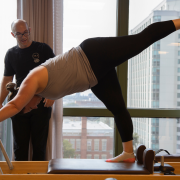Looking To Improve Your Mobility? Learn How Pilates Can Help.
Our bodies have the ability to adapt and change based on the positions we place it in every day. This means that if you stop utilizing your joints and muscles in their full range of motion due to poor strength training techniques, injury or inactivity, your body will find comfort in a more limited range of motion. Many times, this causes us pain.
Mobility is the foundation of fitness. The National Federation of Professional Trainers (NFPT) defines mobility as “a joint’s ability to explore its full range of motion, taking into account restricted muscle tissue, joints, joint capsules, soft tissue and motor control.” When we build strength, power, speed and skill without keeping our mobility healthy, we are more prone to injury and pain.

If you are looking for ways to increase your mobility, adopting a regular Pilates practice is a great place to start. At FFC, our Pilates instructors help you identify where your range of motion is restricted by identifying the tissue that’s the issue. In a lot of cases, the muscle tightness you are feeling is not the root cause of your pain. The cause is usually identified somewhere else along your weak muscular chains. For example: Member A and B both have low back pain, but member A’s pain is caused by weak glutes while member B’s pain is caused by lack of rotation in their upper back.
Related: Why Pilates Is A Great Choice For Your Next Recovery Day
Determining the root cause of your pain ensures that you can take the necessary steps to improve your range of motion and alleviate any pain. Like the example above, you may find out that your glute muscles need some activation, or that you need to adjust the way you are sleeping (FYI – the number one cause of body stiffness is your sleeping position). Pay close attention to the signs your body is exhibiting when it comes to muscular pain. Cramps (such as calf or hamstring charlie horses) are a sign from your body alerting you that something isn’t working in your connective chain, thus shutting the body down.
Once you’ve narrowed down where your range of motion is restricted, it’s time to add some new mobility and stability exercises to your routine. Unlike foam rollers and lacrosse balls, which are useful tools but not a long-term solution for mobility, Pilates makes lasting improvements to your mobility. Pilates builds strength through a full range of motion, strengthening your small stabilizing muscles and teaching you to retrain poor workout and postural habits – and preventing injury before it happens.
Related: 5 Common Misconceptions About Pilates
With Pilates as your foundation, you can safely lift heavier, run faster and live longer.
Ready to give Pilates a try and start improving your mobility? For a limited time, we are offering Pilates For Recovery – specially-designed classes to help you recover and be your best self. Learn mobility, strength, and stretches to treat your body right. Click here for more information and to sign up today!

Post written by FFC Pilates Coordinator Jamie Loger.



